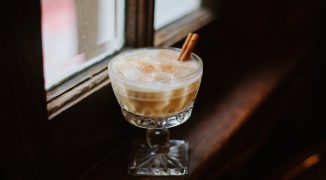Bartenders may be less famous for their book collections than their drink recipes, but that doesn’t mean they don’t have a well-stocked libation library at home. With what seems like dozens of new bartending books being published every month, we wanted to sort the go-to classics, all-time favorites, and “desert island” tomes from the rest. So, we spoke to five bartenders across the U.S. who let us in on what they consider their bartending bibles.
Chris Barrett, Ludivine in Oklahoma City, bartending since 2004
Picking a number one bartending book is tough. But, from a historic point of view, I’d have to say “Imbibe” by David Wondrich. As far as the craft cocktail renaissance goes, he’s the historian. “Imbibe” gives technique, knowledge, and recipes all framed by history. This book is great for bartenders because we build on what’s come before us. Learning the history of drinks shows you the why—like why you’re using bitters, why the ratios are a certain way.
My second pick would be “The Craft of the Cocktail” by Dale Degroff—the first book I read when I was starting to learn to make cocktails. It’s a basic catch-up for anyone who’s not made craft cocktails, or for a bartender who hasn’t had any real instruction or training. Degroff walks you through mastering techniques such as stirring, appropriate garnishes and how to make them, and how to properly zest.
Robin Jackson, Oldfield’s Liquor Room in Los Angeles, bartending since 1995
I like “The Flavor Bible,” by Karen Page and Andrew Dornenburg. Although it’s a cookbook, it opened my mind to the creative possibilities flavor combinations, helping me understand how different ingredients can balance out or create a complex cocktail. I’ve been collecting cocktail books for the last fifteen years. I probably have sixty. But, I find myself going to “The Flavor Bible” almost every day.
My other choice would be the “PDT Cocktail Book: The Complete Bartender’s Guide from the Celebrated Speakeasy,” by Jim Meehan. The drinks are simple yet complex and he includes a lot of classics. My favorite is “The Lion’s Tooth,” which uses dandelion root-infused Rittenhouse rye whiskey, sherry, Yellow Chartreuse, and St. Germain. Besides the recipes, it’s pretty, with nice illustrations and woodcuts. If you want to open a bar, it also gives an overview of their process and what worked for them at their New York City speakeasy, Please Don’t Tell.
Chris Hannah, French 75 in New Orleans, bartending since 1997
My favorite book is Ted Haigh’s “Vintage Spirits and Forgotten Cocktails.” It not only has the recipes, but also a short-form history of each cocktail, which helps me because bartending is not just about making the drinks, it’s also about talking to the guests. They enjoy reading the descriptions of the drinks as much as I do. If you get the book, check out the description for the Widow’s Kiss, which is written like the opening of a play. It’s my favorite description of any drink—comparing the taste of the cocktail to the feeling of finding in a dusty attic old love letters wrapped in lace in your grandmother’s 1914 suitcase. The drink itself is also my favorite from the book. It’s an all-booze, stirred, sipping cocktail made with Calvados, Yellow Chartreuse, Benedictine, and Angostura bitters.
I’d also recommend Death & Co.’s cocktail book, “Death & Co: Modern Classic Cocktails.” It gives good direction in creating new cocktails, balancing cocktails, and the methodology behind mixing. Bartenders should give it to their barbacks who aspire to be bartenders.
Jamie Kilgore, Planter’s House in St. Louis, bartending since 1999
When I first started bartending there were significantly less cocktail books on the market. One of the most exciting books I initially found was “Vintage Spirits and Forgotten Cocktails” by Ted Haigh. The cocktails are well-known now, but at the time it was exciting. The individual histories of the drinks opened my eyes to the idea that what is old can be new again and some things don’t go out of style. When it first came out, it was unlike any of the other cocktail books that were available and, although it’s all about classic cocktails, it is a modern book.
“The Savoy Cocktail Book” by Harry Craddock from 1930 is another favorite. It is significantly older and so there are many classic cocktails in there. It set the bar for being a cocktail encyclopedia and has great illustrations.
Del Pedro, Tooker Alley in New York City, bartending since 1987
I don’t know how much younger generation bartenders use David Embury’s “The Fine Art of Mixing Drinks,” but, for me, it was a super important book. A lot has happened since it was published in 1948, so older books like this can seem a little dated. But, if you forced me at gunpoint, this the book I’d refuse to be without. It’s my desert island cocktail book.
Lately, I’ve been using “Cocktail Boothby’s American Bartender,” by William T. Boothby, which was republished by Anchor Distilling. It’s a great book with insight into the 19th century cocktail culture, written by someone who was serious about what he did and was good at it. I find it to be rich, amusing, lively, and fascinating. We have the Boothby Manhattan on our menu and it’s doing well. Made with orange and Angostura bitters and topped with champagne, it fits in with the modern palate that wants drier drinks.
Thirsting for more? Other book recommendations from these five cocktail craftsmen include: “The Joy of Mixology,” by Gary Regan; Jerry Thomas’ Bartenders Guide: “How To Mix Drinks or a Bon Vivants Companion,” by Jerry Thomas; “The Old Waldorf-Astoria Bar Book,” by Albert S. Crockett; and, for you tiki drink enthusiasts: “Beachbum Berry’s Potions of the Caribbean,” by Jeff Berry.





